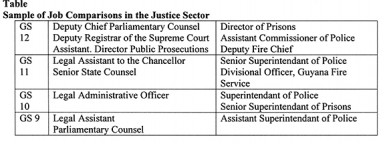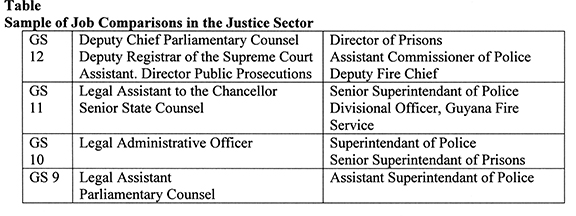Dear Editor,
My grandmother frequently would observe: “Drunk or sober, count your number.”
The recently published report on written exchanges in the National Assembly regarding salaries (and allowances) within the Judicature, may be an apt example of the need to count the actual ‘numbers’ applicable ‒ not only to the Judicature, but perhaps, more importantly across the whole justice sector.

The emphasis here is on the grades, rather than on the actual salaries paid the respective incumbents, a good proportion of whom are in fact ‘contracted employees’ whose individual remuneration is not necessarily constricted by the published dollar bands.
What is important however is the comparisons to be made in job values based on the assumption of the published scales being actually implemented.
Of interest must be the comparison (if not contrast) between the quality of professional (or academic) qualifications required for performance of tasks and responsibilities within one group of agencies, and those of less stringent professional (academic) standards which appear to be accepted within the second group. The following Table should stimulate some examination and reflection.
It will be noted in the meantime that the comparable posts shown in the matrix under Public Prosecutions have been italicised for easy reference:
While the post of Deputy Director is listed in these records, other documentation reveals that this post falls within the purview of the Judicial Service Commission.
By some quirk the post of State Counsel is shown at GS10 within Legal Affairs; and at GS09 in Public Prosecutions.
It is also for discussion whether for example, the post of Deputy Chief Fire Officer is objectively evaluated as equal to that of the Assistant Director of Public Prosecutions; and at the same time ‘senior’ to that of Senior State Counsel. Somehow the post of Chief Fire Officer does not appear in the National Estimates.
There must also be a case for enquiring into the criteria used for according the same status (and value), to the posts of Assistant Superintendant and Chief inspector of Police), as a State Counsel in Public Prosecutions, ie, GS09.
Additionally the focus of comparison ought not to be limited only to the abovementioned posts and agencies. Indeed a wider examination of comparabilities across the whole justice sector should be considered justifiable. Certainly it is arguable that there should be a requirement to identify the common criteria, which appropriate technical and objective evaluation would normally apply, to arrive at the conclusions reflected in the published gradings.
I hope that the protagonists would be sober enough to heed my grandmother’s advice seriously, and reflect on the implications of the above ‘numbers.’
Equally important, however, should be a further enquiry into how many of the relevant posts are encumbered in relation to the approved establishment.
Yours faithfully
EB John





